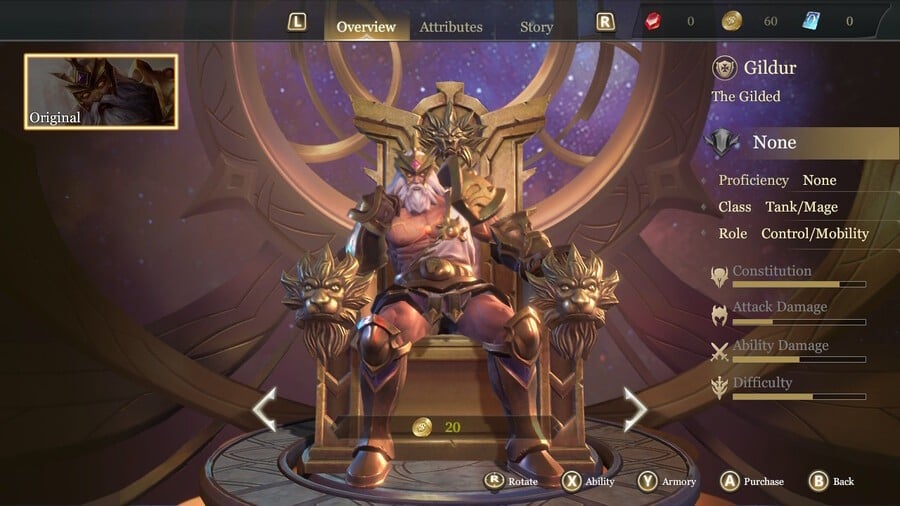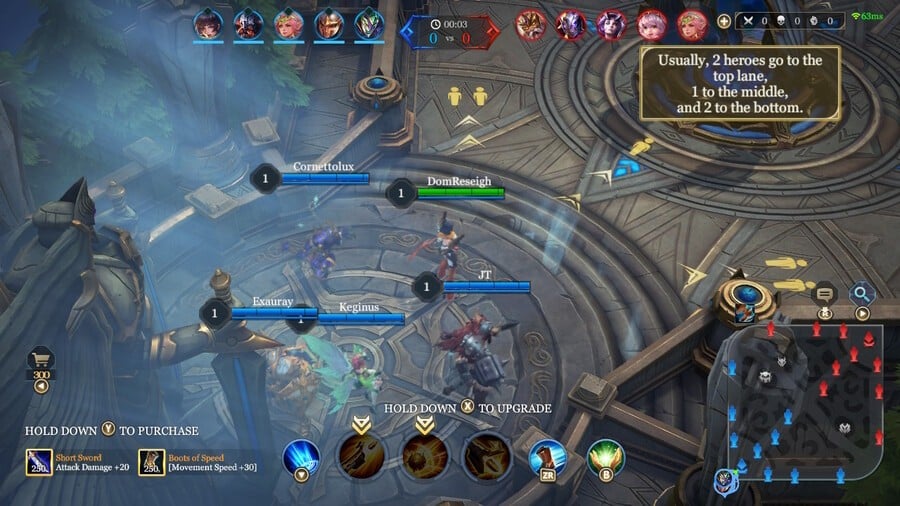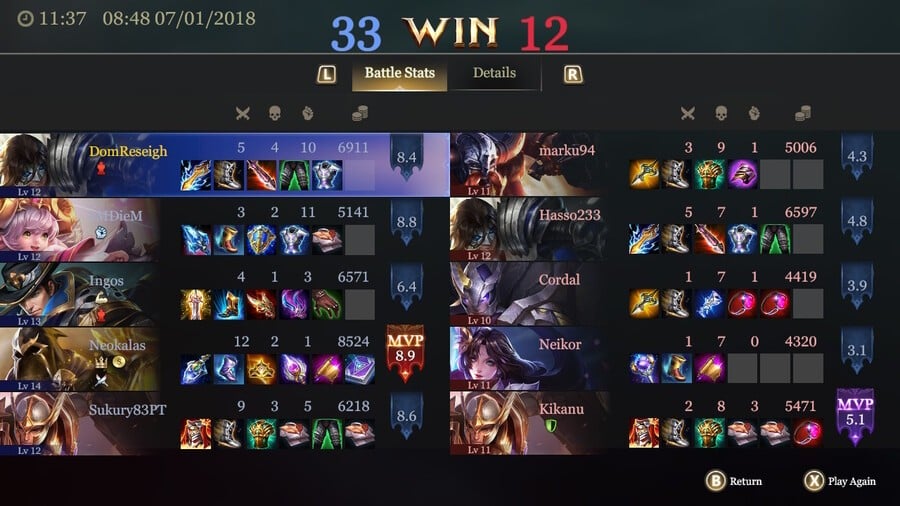
Nintendo Switch hasn't even hit the 18-month mark and it's already been acquiring all manner of popular new genres. It's jumped onto the hero shooter bandwagon with the excellent Paladins and ticked the battle royale box so hard with Fortnite it's gone right through the paper and snapped the pen for good measure.
So now it falls to a genre that's long been one of the most impenetrable, a PC mainstay that's become a crown jewel of the eSports scene - the MOBA. Known as a Multiplayer Online Battle Arena to its friends and family, the classic MOBA template remains incredibly popular on PC thanks to the success of Dota 2 and League of Legends.
Arena of Valor - a new, previously mobile-exclusive instalment in the genre - shares a publisher with the latter (Chinese giant, Tencent Games, no less) and it's that shared gene pool that's helped take an often intimidatingly deep concept and turn it into a fast-paced and rewarding experience that's just right for the 'pick up and play' ethos of a handheld-friendly console.

In fact, the free-to-play Arena of Valor takes more than inspiration from LoL. It outright copies many a character, right down to their costumes and abilities, but considering both games are aimed at very different markets, it's a cross-breeding of ideas that's unlikely to cause the industry to capsize. If anything, building on the solid foundation of a game like LoL only helps build AoV's authenticity.
The concept is mercifully simple. Select a match type - they come in 5v5, 3v3 and 1v1 variants - select a hero from the 34 available then head into battle. Only a handful are available from the start, but if the unlock system from the mobile version follows suit on Switch, you'll be unlocking new characters every few days through log-in bonuses, in-game challenges and special events. With skins and skills also dolled out regularly, it promises to keep you coming back for more.
Anyway, back to the action. Much like LoL, each map is divided in half, with three channels linking one end to the other. Each team has a core they need to protect - destroy your enemy's core and the game is over. However, you'll need to destroy towers along the way - which serve as a line of defence along each route - as well as engaging enemy heroes. It can be a little overwhelming at first, especially if you're new to this genre, but its top-down view and myriad abilities soon start to open up.

Each hero has a unique set of abilities tied to 'L', 'R' and 'LZ', 'RZ', 'B' and 'A' and a number of these can be upgraded throughout a battle. To do this you'll need to get in among the action, killing enemy heroes, taking out minions (AI-controlled fodder that follow you into battle) and increasing the credits you can spend. Soon you realise respawning back at your own core isn't a punishment, it's simply a way for you to upgrade a given power, making it far more potent by the time you rejoin the action. The controls also map over surprisingly well. The mobile version was a pure touchscreen affair, so being able to use the analog sticks on the Joy-Cons is instantly more tactile and responsive than a digital joystick on screen.
Many of your attacks also have cooldowns, so there's a tactical nature of knowing when and where to use them. Many of the heroes also complement each other. It's not as strictly team focused as Paladins and its objective-based action, but heroes are still divided into distinct categories - Tank, Warrior, Assassin, Mage, Marksman and Support.
Having a powerful heavy character such as the Viking-esque Ormarr ploughing into battle with his giant hammer is a great way to cause mass havoc near a tower, but his life expectancy can be dramatically increased if you have a Marksman such as Violet taking powerful potshots outside the AOE of a tower, or a Support such as Alice with her helpful shield abilities. Matches may only last around 10-minutes long each (regular MOBA matches on are usually around the half-hour mark), but there's still a pleasing amount of depth once you stop aimlessly hacking and slashing.

Performance-wise its mostly good news. Designed to run on the same mobile processors found in Nintendo Switch, Arena of Valor usually only stutters when a match begins, with a short but frustrating drop in frames. Load times between matches are also painfully long, but once you're into a match you're only kept waiting by a cooldown timer between deaths. Its character designs look a little muddy on screen compared to their much higher-res cousins shown off in menus, but the in-game experience is still clear enough to keep the action discernable. The controls also map well to the Joy-Con or Pro Controller, offering just as much dexterity in handheld mode as it does tabletop/docked mode.
Overall, Arena of Valor's short yet sweet beta has left us surprisingly optimistic for its eventual release. It looks and plays much like its genre counterparts, despite being of mobile origins, and there's still plenty to enjoy and earn through in-game achievements for those not looking to spend real-world cash. With tweaked graphics and support for both casual and ranked play, Arena of Valor promises to be a huge new addition to Switch's handheld library when it arrives later this year.
Have you played Arena of Valor on Switch? Are you a big MOBA fan? Share your thoughts on the game in the comments below...





Comments 36
I don't like AOV, But that game was played TOO MUCH in my country.
I wonder the Casual reaction when they see AOV on Nintendo Switch instead of on mobile.
It plays very smooth and well. Can't wait for the release.
I really enjoyed it. I’ve not played much as you can’t carry anything to the final release and I know I’ll want to play a lot when it comes out. I was really impressed by the character models and animations
I played a few matches. It's my first MOBA...and I liked it!
Is this the game that’s huge in Asia? Never tried this type of game before but looks pretty good. Hopefully it will help the switch out east.
... it's a sensation?
@Paraka something like 200 million players in China alone. I've never played a MOBA before but I'm enjoying it so far
@NintendoFan4Lyf Couldn't agree more about the tutorials as a new MOBA player.
Even looking up things you get thrown slang words like 'jungling' at ya.
I have loved playing this game on my Switch (Closed Europe Beta Access - WHOO!) and have quickly gotten to grips with how things work. Normally this kind of game wouldn't be my kind of thing at all - seems much too advanced for me. But I did some major research on LOL months before and that knowledge easily transferred over. You have to be very flexible and fluid in a match in a way I'm not used to. You have to know when to pick a fight, see it through, and even retreat at the right times. Often you'll find someone hiding in a brush waiting to ambush you if you're not careful, or several enemies coverging on your position and you only figure it out when its too late. But thats honestly part of the fun. I've had many losses and stuff that have been frustrating, but that was only when I felt I didn't quite "get it". Now that I do, and things have clicked, even losing isn't that big a deal to me. Its largely focused on what hero you use, what hero you're against and what equipment you have on you at the time (same with them) and these can be changed on the fly at any time. Like, the depth to this game keeps going deeper and deeper - which means the replayability is also there too. For a free to play game (I assume it's free to play, at least) I'd 100% recommend it to any and all switch owners. Beginners should get their hands on this game as quick as possible as it's easier than ever to get into a Moba, I think.
@Mr_Pepperami
"Is this the game that’s huge in Asia? "
Even my students and some male teachers in my school played that game Too Much.
Oh, please....
@Anti-Matter yeah I figured it was this one. Meant to be crazy popular.
In the full version you can also play as Superman, Wonder Woman, Batman (Who is an Assassin class) Joker, and Flash.
(I believe Green Lantern is coming too)
I enjoy it, but it's a bit simple compared to say, Heroes of The Storm, which I prefer. Still, plays pretty well and I destroy as Krixi
haven’t played any MOBAs for while but I used to be pretty into smite, I’m definitely excited for this.
Played this during the closed BETA.
It has wonderful graphics and runs pretty smooth overall. When I spawned in game I was surprised to see how much it looked and played like LoL. My character was not J4 but I am going to call him J4 because he played strikingly similar to him. I went mid lane and dominated but it seemed like anyone with knowledge of LoL would have done well regardless.
Overall I would say I am excited for this to come out but I would like to see them make it more challenging.
Played this a bit on my phone before, and it's well done, but I feel like I'm already too invested in League to deep-dive into another moba.
Wow! Those screenshots look very good. The Switch impresses me more and more every day.
It was fun. I put in a good 3 hours in the beta. I imagine I will play more later
@Refurin - I was referring it to the "Switch's MOBA" bit.
It cannot be a sensation when the market hasn't even landed yet.
I myself have been playing it on SWITCH and can confirm that the game is fantastic. I will also be playing it upon release!
@Paraka Ah yeah that makes sense. Apologies for the confusion
i'm loving this game
It was OK. I'm downright hating the clunky basic attacks though. Playing a melee is downright dreadful, the only characters I felt were acceptable were ones with hard CC or pulls (like Mina). Having to pretty much click the abilities twice to make some of them go off is pretty annoying as well.
All in all it was a positive experience, though me being really great at playing Alice when all I wanted to do was master Butterfly (whom I sucked incredibly much at playing) felt a bit off-putting. That feeling when your favorite character is one that you just do not click with on any level... Yum.
This game is soo addictive!
I will admit to having fun with this beta, however since this game was originally on mobile and is made by Tencent, I am very cautious to see how bad the micro-transactions will be.
You can see it in the screenshots, purchase extra attack and movement speed on the go during battles... sigh.
I mean, at least it's free. Unlike the also pay-2-win mechanics in Battlefront 2, which cost $60 just for admission.
@SmaMan purchase with points earned during the battle... that’s nothing to do with real world money, it’s like XP
The esport part of the trailer is a joke right? There's not a competitive scene for a mobile game surely?
Well, it sound better than the battle royale sub-genre and whatever Overwatch's and its imitators' sub-genre is, but I still wish they just give us the option of a simple deathmatch mode.
@Kai_
?
This genre basically built eSports. And the game is from the same parent company who makes League of Legends, so this is no small fry mobile game. This is a full scale League of Legends type PC game that's simply tapping into new markets.
Although admittedly I'm not sure how big the competitive scene is for this game, one thing I do know is that it exists. I think this is one of the biggest games in the world right now, although thus far it's predominantly been the Asian market. This one makes Fortnite seem small in comparison though.
I'm too invested in Heroes of the Storm to dive into another MOBA. Been playing that since the 1.0 launch and still enjoying it, so not about to stop.
@Kai_ Doesn't seem too surprising as it may be the most popular video game in the world according to what I found with a one minute search. Do a search on it. Last year it was reported that there were 80 million daily active users and 200 million registered users.
Besides mobile is a decent interface for this sort of game.
> and ticked the battle royale box so hard with Fortnite it's gone right through the paper and snapped the pen for good measure.
...that was a bit much.
I’m not a big fan of the game. Loading times were bad, the game kept force closing on me, waiting on the matches was a joke despite there being enough players. I know it was a beta but it left a bad taste in my mouth. Probably wouldn’t download it for free let alone pay for it.
@Anti-Matter It could be interesting actually. Will they pick up Switches or stay on the device they already have? The question is if progress carries over.
I'm not into MOBAs so I can't tell you if it's as popular outside Asia. LoL is still most popular here, but then again Eastern Europe has been a bastion of PC gaming.
Having stayed very far from LoL and only having played Smite as a MOBA (which is much more Arcade in its gamplay), I was pleased with that Beta. I'm looking forward to the real thing.
Tap here to load 36 comments
Leave A Comment
Hold on there, you need to login to post a comment...